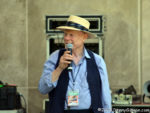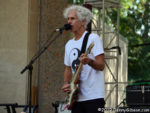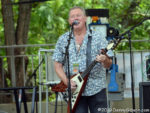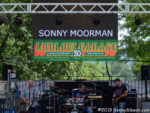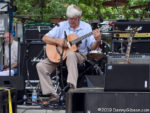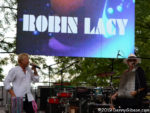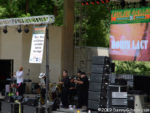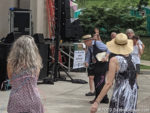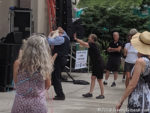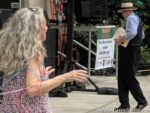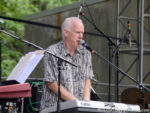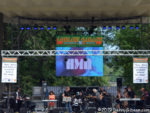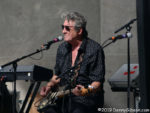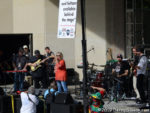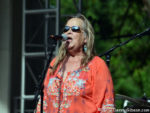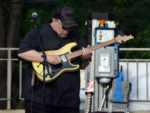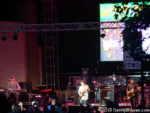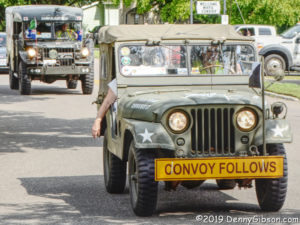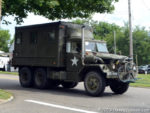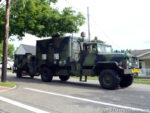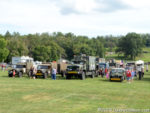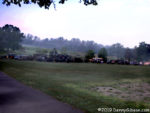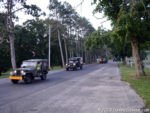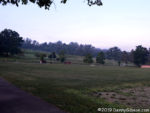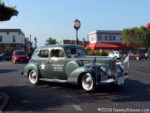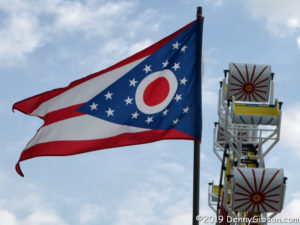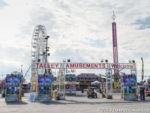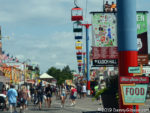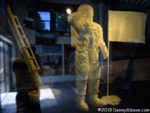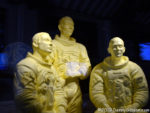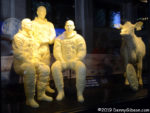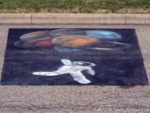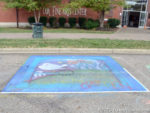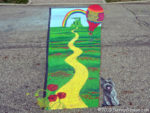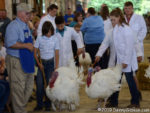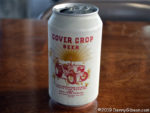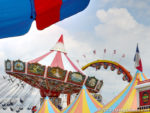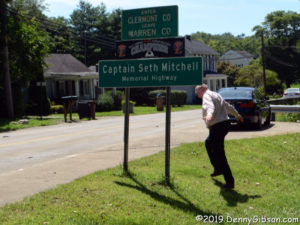 There are 3142 counties in the United States of America and a surprising number of people have visited all of them. The Extra Miler Club is an organization for folks who have that as a goal. Prior to yesterday, its 100% Club had 61 members. Member number 62 is Hugh Donovan who completed the task by entering Clermont County, Ohio, at 1:50 PM, August 24, 2019.
There are 3142 counties in the United States of America and a surprising number of people have visited all of them. The Extra Miler Club is an organization for folks who have that as a goal. Prior to yesterday, its 100% Club had 61 members. Member number 62 is Hugh Donovan who completed the task by entering Clermont County, Ohio, at 1:50 PM, August 24, 2019.
Hugh’s accomplishment is different from and even more impressive than the others because of time. Those people took years or decades to visit every U.S. county or county-equivalent. Hugh’s stated goal, when he started counting on January first, was to do it within the year. He did it in 236 days, about 2/3 of a year, and that included marking time for several days so as not to get to the party too early.
 I first heard of Operation 3142 sometime in April, about the time that Hugh reached the halfway point of his quest. Even then it was hardly a given that he would succeed. Ripping through multiple counties per day was one thing on the eastern mainland but quite another in other areas. In his favor was the fact that one of the big challenges, Hawaii, was already tallied. On the other hand, another big challenge, Alaska, remained and would be even tougher.
I first heard of Operation 3142 sometime in April, about the time that Hugh reached the halfway point of his quest. Even then it was hardly a given that he would succeed. Ripping through multiple counties per day was one thing on the eastern mainland but quite another in other areas. In his favor was the fact that one of the big challenges, Hawaii, was already tallied. On the other hand, another big challenge, Alaska, remained and would be even tougher.
Impulsively I thought that Alaska might be the place for the big finish. Hugh and his team were much wiser. Getting the last county in some remote spot might be dramatic but it was also risky. If the end of the allotted year was approaching, reaching anywhere in the far north would be iffy. If December came with places like the Aleutians not yet visited, those visits just might have to wait until spring. There was another reason for not finishing in Alaska that I hadn’t considered at all. It would simply be more fun to celebrate victory where friends and family could join in. Maybe that’s why Hawaii, reachable and highly enjoyable in December, was knocked off early.
 Even in summer, hitting all of Alaska had some hiccups and took more than two weeks but by mid-June it was done. Although the to-go count had been dropping rapidly, Hugh had resisted revising his target date. Things now seemed much more predictable and he announced that he now anticipated completion at the end of September. That would beat the original goal by three months and reality would be even better. There were still nearly 1000 counties to be reached but they were all grouped in the heart of the mainland, and for the first time I started thinking that the final county might be within some reasonable distance of my home.
Even in summer, hitting all of Alaska had some hiccups and took more than two weeks but by mid-June it was done. Although the to-go count had been dropping rapidly, Hugh had resisted revising his target date. Things now seemed much more predictable and he announced that he now anticipated completion at the end of September. That would beat the original goal by three months and reality would be even better. There were still nearly 1000 counties to be reached but they were all grouped in the heart of the mainland, and for the first time I started thinking that the final county might be within some reasonable distance of my home.
 But not only would this revised completion date be soundly beaten, the final county would be within an unbelievably reasonable distance of my home. The white area on his scoring map was steadily shrinking with its center moving to the east. On August 1 a revised — and quite precise –completion date was announced that trimmed more than a month from the end of September target. Hugh planned to enter his 3142nd county on August 24. That was barely three weeks away from the announcement date but astonishing me even more was the news that the final county would be one barely three miles away from my door. In addition to the county itself being ridiculously close, a planned celebration would be taking place nearby at a familiar brewery. Attending was an instant no-brainer.
But not only would this revised completion date be soundly beaten, the final county would be within an unbelievably reasonable distance of my home. The white area on his scoring map was steadily shrinking with its center moving to the east. On August 1 a revised — and quite precise –completion date was announced that trimmed more than a month from the end of September target. Hugh planned to enter his 3142nd county on August 24. That was barely three weeks away from the announcement date but astonishing me even more was the news that the final county would be one barely three miles away from my door. In addition to the county itself being ridiculously close, a planned celebration would be taking place nearby at a familiar brewery. Attending was an instant no-brainer.

 There was a small group gathered at the county line a little ahead of when Hugh planned to cross it. Fortunately, some in the crowd were more attentive than I and knew what to look for. My first glimpse of Hugh was after he had exited the car driven by his son and was beginning to walk the last 50 or so yards to the sign marking the country boundary. He stepped across to cheers and applause.
There was a small group gathered at the county line a little ahead of when Hugh planned to cross it. Fortunately, some in the crowd were more attentive than I and knew what to look for. My first glimpse of Hugh was after he had exited the car driven by his son and was beginning to walk the last 50 or so yards to the sign marking the country boundary. He stepped across to cheers and applause.
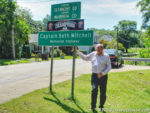

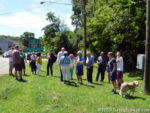 Several posed photos followed with many including family and friends who had assisted in planning and executing the numerous journeys. That’s the A team in the middle picture. Hugh is in the center with, left to right, his son, wife, daughter, and grandson. As you probably suspected, the third picture was not posed.
Several posed photos followed with many including family and friends who had assisted in planning and executing the numerous journeys. That’s the A team in the middle picture. Hugh is in the center with, left to right, his son, wife, daughter, and grandson. As you probably suspected, the third picture was not posed.
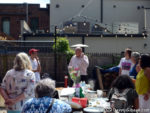
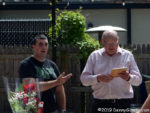 In time, things moved to the nearby Narrow Path Brewery where some fairly informal formalities took place. Extra Milers Club Vice President, Jonathan Riehl, was on hand to present Hugh with a plaque honoring his accomplishment. The club also awards certificates for hitting certain milestones like 500 or 1000 counties but Hugh blew through those so fast there was no time to mail them so Riehl just handed them over en masse. Then Hugh did a little talking but most of what he said was thanks. It was pretty clear that he considered the most impressive part of what he had accomplished to be the routing and other logistics management that others had contributed. He was proud of what he had done but seemed even more proud of what his son, daughter, wife, and grandson had done. Cool guy.
In time, things moved to the nearby Narrow Path Brewery where some fairly informal formalities took place. Extra Milers Club Vice President, Jonathan Riehl, was on hand to present Hugh with a plaque honoring his accomplishment. The club also awards certificates for hitting certain milestones like 500 or 1000 counties but Hugh blew through those so fast there was no time to mail them so Riehl just handed them over en masse. Then Hugh did a little talking but most of what he said was thanks. It was pretty clear that he considered the most impressive part of what he had accomplished to be the routing and other logistics management that others had contributed. He was proud of what he had done but seemed even more proud of what his son, daughter, wife, and grandson had done. Cool guy.
There may be a book coming out of this adventure. I certainly hope so. Until then, pieces of a most interesting story can be glimpsed by scrolling through the posts at Operation 3142. Nicely done Hugh. Congratulations. Thanks for wrapping things up in my neighborhood.

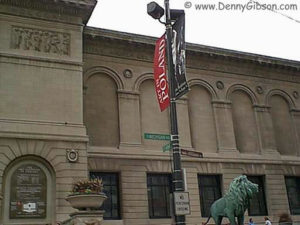
 A lot of things about the site have changed over the years but some things begun with that first trip have stuck. The concept of a page for each day with access to the next and previous day has been in place since the beginning as has a cover page with direct access to individual days. The idea of using the daily “Next’ and “Prev” button to (usually) represent the vehicle being used also goes back to that first trip. An animated GIF showing progress has been used on a few subsequent trips but it requires knowing the full route in advance and that’s often not the case. Besides, it’s a fair amount of work.
A lot of things about the site have changed over the years but some things begun with that first trip have stuck. The concept of a page for each day with access to the next and previous day has been in place since the beginning as has a cover page with direct access to individual days. The idea of using the daily “Next’ and “Prev” button to (usually) represent the vehicle being used also goes back to that first trip. An animated GIF showing progress has been used on a few subsequent trips but it requires knowing the full route in advance and that’s often not the case. Besides, it’s a fair amount of work.
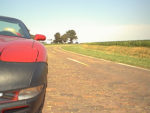
 The final cover page for that trip talks about it being temporary. As I said at the time, I expected it to go away because “I’ll need the space or retiring it will just seem right.” Web space became increasingly cheap and apparently retiring it never seemed right. Two decades later that first trip journal is still online and I’ve added 155 more. There is a
The final cover page for that trip talks about it being temporary. As I said at the time, I expected it to go away because “I’ll need the space or retiring it will just seem right.” Web space became increasingly cheap and apparently retiring it never seemed right. Two decades later that first trip journal is still online and I’ve added 155 more. There is a 
